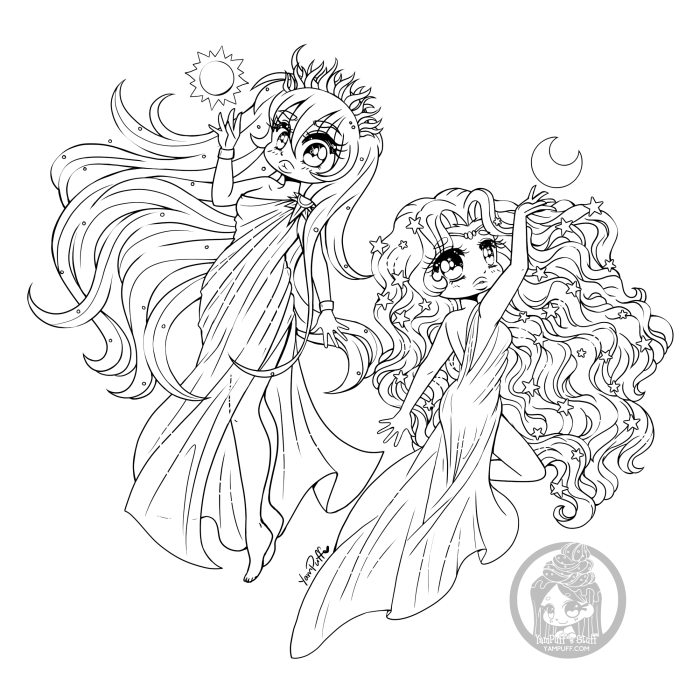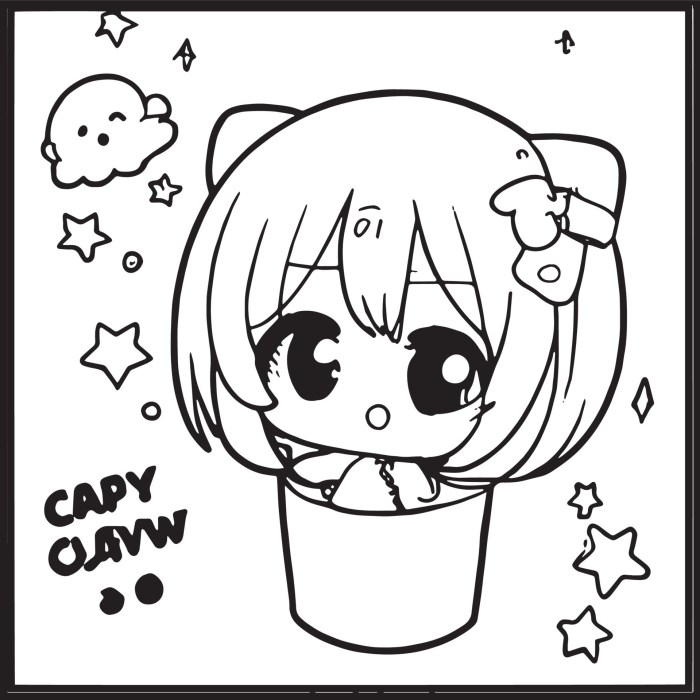Target Audience Definition

A cute chibi coloring book aims to engage a specific demographic of young children with its appealing art style and simple design. Understanding this target audience is crucial for maximizing the book’s appeal and ensuring its success. The design and content should directly address the preferences and developmental stages of the intended users.The ideal age range for a cute chibi coloring book is generally between 4 and 8 years old.
This age group possesses the fine motor skills necessary for coloring within lines and demonstrates an increasing interest in creative expression and imaginative play. Children in this age range are also particularly drawn to characters that are visually appealing and easily relatable.
Cute chibi coloring books offer a delightful way to unwind, their simplistic charm contrasting nicely with more dramatic themes. For those seeking a slightly more mature coloring experience, consider the emotional depth found in it ends with us coloring book , which offers a different artistic style. However, the simple joy of coloring cute chibi characters remains a popular and accessible creative outlet for many.
Age Range and Interests
Children aged 4-8 are typically in the pre-operational and early concrete operational stages of cognitive development, according to Piaget’s theory. This means they are developing their ability to think symbolically and understand the world around them through imaginative play. Their interests often center around fantastical creatures, bright colors, and simple narratives. A coloring book featuring easily identifiable characters with clear, uncluttered designs will resonate well with this age group.
They are also developing their fine motor skills, making coloring a satisfying and engaging activity.
Appealing Characteristics of a Coloring Book
Several key characteristics contribute to a coloring book’s appeal for this age group. Firstly, the illustrations should be large and simple, allowing for easy coloring and avoiding frustration. Secondly, the characters should be visually appealing, cute, and expressive, engaging children’s imaginations. Thirdly, the use of bright, vibrant colors is essential to stimulate interest and creativity. Finally, a variety of characters and scenes provides opportunities for repeated use and extended engagement.
The paper quality should also be considered; thicker paper prevents bleed-through and improves the overall coloring experience.
Types of Cute Chibi Characters
The success of a chibi coloring book hinges on the selection of characters. Several types of cute chibi characters resonate strongly with this age group. These include: animals (such as adorable kittens, playful puppies, or friendly pandas), fantastical creatures (like unicorns, fairies, or dragons with exaggerated features), and anthropomorphic characters (animals with human-like characteristics and expressions). These characters should exhibit exaggerated features, such as large eyes and small bodies, which are characteristic of the chibi style.
Consider including characters performing simple actions or interacting in playful scenarios, further enhancing the imaginative element. Examples might include a chibi cat playing with a ball of yarn, a chibi unicorn flying amongst the clouds, or a chibi panda eating bamboo.
Content and Theme Ideas

This section details three distinct themes for a cute chibi coloring book, along with character ideas and a sample page illustration. The themes are chosen to appeal to a broad range of children, offering variety and engaging visuals. Each theme provides opportunities for creative coloring and imaginative play.
The selection of themes considers the target audience’s preferences for cute and appealing characters, as well as the potential for diverse and engaging scenes within the coloring book pages. The character designs are intended to be simple enough for young children to color, yet detailed enough to be visually interesting.
Theme: Adorable Animals
This theme features a collection of cute chibi animals engaged in various activities. The focus is on creating endearing and expressive characters that children will find appealing.
- Chibi Panda munching on bamboo
- Chibi Squirrel gathering acorns
- Chibi Kitten playing with a ball of yarn
- Chibi Puppy chasing its tail
- Chibi Penguin waddling on the ice
Theme: Whimsical Fantasy
This theme introduces children to a magical world filled with enchanting chibi creatures and fantastical settings. The designs aim to spark creativity and imagination.
- Chibi Unicorn with a rainbow mane
- Chibi Dragon breathing sparkling hearts
- Chibi Fairy fluttering amongst flowers
- Chibi Elf playing a tiny flute
- Chibi Gnome tending a miniature mushroom garden
Theme: Everyday Adventures
This theme portrays chibi characters in relatable everyday scenarios, fostering a sense of familiarity and connection for young children.
- Chibi Child riding a bicycle
- Chibi Child playing with building blocks
- Chibi Child eating ice cream
- Chibi Child reading a book
- Chibi Child sleeping with a stuffed animal
Sample Page: Whimsical Fantasy – The Fairy’s Tea Party
This page depicts a charming scene in a sun-dappled meadow. A chibi fairy with iridescent wings, wearing a tiny floral dress, sits at a miniature mushroom table. She’s surrounded by three other chibi fairies, each with unique colored wings and dresses. One fairy is pouring tea from a thimble-sized teapot, another is holding a miniature cake, and the third is carefully arranging wildflowers in a tiny vase crafted from an acorn cap.
Butterflies flutter around them, and tiny flowers bloom all around the table. The background is a soft green meadow with bright yellow sunflowers and fluffy white clouds. The scene is light-hearted and peaceful, inviting children to color the vibrant details and create their own magical world.
Additional Features and Elements: Cute Chibi Coloring Book

Enhancing a chibi coloring book beyond simple coloring pages adds significant value and playability for young children. Including bonus content and interactive elements transforms it from a passive activity into an engaging and multifaceted experience. This section details the incorporation of such features to maximize the book’s appeal and entertainment value.Adding bonus content like stickers, stencils, or simple games extends the playtime and creative opportunities offered by the coloring book.
These additions provide children with alternative ways to interact with the book’s theme and characters, fostering creativity and imagination. Consideration should be given to the age range of the target audience when selecting appropriate bonus materials.
Bonus Content Suggestions, Cute chibi coloring book
A selection of chibi-themed stickers featuring the book’s characters and objects would be a welcome addition. These could be used to decorate the completed coloring pages or to create independent scenes and stories. Similarly, stencils could provide a guide for more intricate designs, enabling children to trace and color with greater precision. Simple games, such as a “spot the difference” game using two slightly altered versions of a chibi character illustration, or a simple maze featuring the chibi characters navigating a whimsical landscape, could offer additional entertainment.
The games should be easy to understand and complete, aligning with the target audience’s age and abilities.
Activity Page Design
A “Design Your Own Chibi Outfit” activity page complements a coloring book featuring chibi characters. This page would feature a simple Artikel of a chibi character, along with a variety of clothing items, accessories, and decorative elements, all drawn in the same chibi style. Children can cut and paste (or draw) the elements onto the character Artikel, creating their unique chibi fashion designs.
This page could also include space for children to add their own creative touches, further encouraging their imagination and artistic expression. The color palette should be consistent with the overall aesthetic of the coloring book. For example, the page could include various hats, shirts, pants, shoes, and accessories like bows and wands, all in bright, cheerful colors.
Interactive Elements
Hidden pictures and connect-the-dots activities can be easily integrated into the coloring book’s design. Hidden pictures could be incorporated into the background of existing coloring pages, adding an extra layer of engagement for children who enjoy puzzles. For example, a hidden picture of a small animal could be subtly integrated into the background of a page featuring a chibi character in a park setting.
Connect-the-dots could use numbered dots to form simple shapes or Artikels of chibi characters or objects, creating a fun and educational activity. These interactive elements should be age-appropriate and clearly visible to avoid frustration. The difficulty level of both hidden pictures and connect-the-dots should gradually increase throughout the book, maintaining engagement without becoming overly challenging.

0